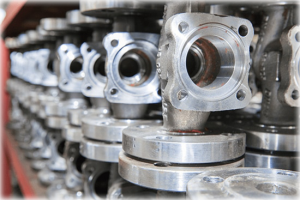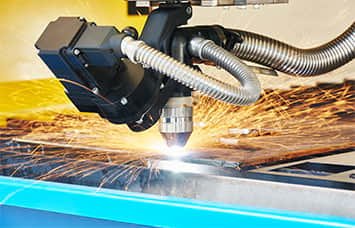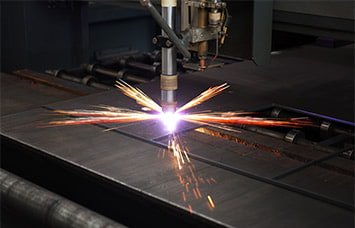Aluminum is a lightweight, non-magnetic, silver-colored metal that can be formed into almost any shape. It can be rolled into thick plates for armored tanks or thin foil for wrappers. It can also be drawn into wire and made into cans. Pure aluminum is soft and has limited strength. Small amounts of elements such as copper, magnesium, and zinc are often added to increase strength.
Aluminum is a comparatively new industrial metal that has been produced in commercial quantities for just over 100 years.

Properties of Aluminum
- Excellent corrosion and chemical resistance
- High strength-to-weight ratio
- Good heat and electrical conductivity
- Easily machined
- Reflects heat and light
Aluminum is a metal that is silver in color, has non-magnetic properties, is light in weight, and can be molded into any desired shape with the implementation of the correct procedures. The versatility of aluminum is so diverse that armored tanks with thick plates of aluminum, wrappers made out of thin aluminum foils, aluminum cans, and thin aluminum wires are all possible dimensions that this metal can be molded into. In other words, aluminum is a highly malleable and ductile metal.
The strength of pure aluminum is very limited and it is found to be very soft in its original state. The addition of little amounts of other metals like copper, zinc or magnesium, to aluminum, is done in order to increase the strength of this silver-colored metal. Aluminum is abundantly available in the crust of the earth and is only third in the highest amounts of availability after oxygen gas and silicon. It is also a relatively new metal that is being used in the industries and produced on a commercial scale for only a little over the last 100 years.
Aluminum Applications
Auto Parts
Aircraft Parts
Engine Parts
Medical Devices
Handles and Knobs
Lighting Fixtures
Electronic Enclosures

Cooking Utensils
Aluminum Alloys
Aluminum 6061
Good mechanical properties and weldability, making it one of the most common alloys for general use. Typically used in the manufacturing of aircraft, watercraft, automotive parts, and bicycle frames.
Aluminum 5052
One of the most popular aluminum alloys used in sheet metal fabrication, it is easily bent, punched, and sheared. Highly corrosion resistant, especially in ocean water. Typically used in marine and aircraft equipment, street lights, fuel lines, and railings.
Aluminum 2024
Good fatigue resistance and average machinability, but is not weldable and has poor corrosion resistance. Used in applications requiring a high strength-to-weight ratio such as aircraft wings, fuselages, and structures under tension.
Aluminum 6063
Good mechanical properties and highly weldable, though strength near welds can be significantly reduced if not heat treated. Used in extruded shapes for architecture, window frames, roofs, tubing, and furniture.
Aluminum 7075
Good fatigue strength and average machinability, but is not weldable and has limited resistance to corrosion. Cost is higher compared to other aluminum alloys. Typically used in aircraft wings, fuselages, bicycle parts, and rock climbing equipment.
Machining Options

CNC Milling

Waterjet Cutting

CNC Turning

EDM

Laser Cutting

Plasma Cutting

Secondary Manufacturing

Surface Finishing
Advantages
-
Transportation:
The combination of lightness, strength and malleability makes aluminum the ideal material for transportation applications. It is used in automobiles, airplanes, railways and marine applications and also for making fuel-efficient engines in cars and trucks. Its low weight reduces fuel consumption and emissions.
-
Construction:
Aluminum facilitates the construction of corrosion-resistant and low-cost buildings. All kinds of aluminum products are used for new construction as well as renovation and due to its strength and lightness, it is used in earthquake-prone zones. It is also a good reflector of light and is often used in lighting fixtures.
-
Vehicles:
A high proportion of the shock inflicted by an automobile in a motor vehicle accident is absorbed primarily by its aluminum structure.
-
Air Travel:
Strong aluminum alloys take the extreme pressures and stresses involved in high altitude flying. Wafer-thin aluminum panels keep the cold out and the air in. Many internal fittings like the seating on airplanes are made from aluminum or aluminum composite in order to save weight and thus save fuel, reduce emissions, and increase the aircraft’s payload.
-
Packaging and Food Processing:
It is non-poisonous, which allows for non-acidic food to be safely wrapped in thin sheets like foil and cooked in vessels. Aluminum cookware is easy to lift, requires considerably less heat than stainless steel or cast iron and utensils heat up quickly and evenly.
-
Electrical Transmission Lines:
Aluminum can be drawn into thin wires which are often used in products such as light bulbs and telephone wires. Most of the high voltage overhead transmission and distribution lines over long distances are also made of aluminum.

